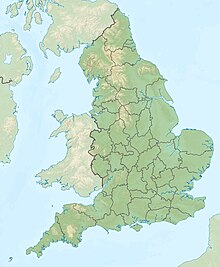Stiperstones
| Stiperstones | |
|---|---|
Marilyn | |
| Coordinates | 52°34′55″N 2°56′06″W / 52.58194°N 2.93500°W |
| Geography | |
| Location | Shropshire, England |
| Topo map | OS Landranger 137 |

The Stiperstones (
Geography
The Stiperstones is noted for its
The principal ones are named as follows, from north-east to south-west:- Shepherd's Rock (grid reference SO373998)
- Devil's Chair (SO368991)
- Manstone Rock (SO367986)
- Cranberry Rock (SO365981)
- Nipstone Rock (SO365969)
- The Rock (SO351963)
Manstone Rock is the highest of these at 536 metres (1,759 ft), and is topped with a
The Stiperstones ridge is a good place to view the
Geology
The tors are formed from heavily
Much of the ground around the tors is covered by head, a gravelly and bouldery deposit arising during the present Quaternary period and deriving from the rocks immediately beneath it. There are also some isolated peat deposits in places. Of particular note is the patterned ground surrounding the tors; some of the best examples of the periglacial features known as stone stripes and polygons in England.[4][5][6]
Wildlife and conservation
The Stiperstones is a
Recently, a project called Back to Purple has commenced, to clear some of the hill of remaining plantations of coniferous and wooded areas, restoring the land to
Cultural references
The general area has a long history of lead mining, most notably during the
The area around the Stiperstones is rich in
The Half Man Half Biscuit album 90 Bisodol (Crimond) contains a track entitled "Descent of the Stiperstones".
An exaggerated version of the Stiperstones is included as a location in the 2020 video game Assassin's Creed Valhalla.[10]
Bog Mine and Visitor Centre
Until the early 20th century lead was mined at The Bog, just west of Stiperstones. The mine at The Bog and the adjacent Stiperstones outcrop were only viable because of a geological movement; over time the movement of the tectonic plates landed at this site, combined with the movement of the earth it crumpled the layers and the softest layers were then eroded away.[clarification needed] After mining stopped, the undisturbed remnants provided a range of wildlife habitats: birds nest in the old buildings, bats roost in the old mine tunnels, and reservoirs and ponds are ideal for aquatic life.[11]
The Bog Visitor Centre is the main facility for visitors to the Stiperstones. It is housed in the former village school and retains its old interior design.[11] It provides historical information about the past workers, mining, and present-day work to restore the landscape. Facilities at the centre include toilets and car parking (with facilities for the disabled including reserved parking, toilets and ramps).[12] Activities include walking, with two main circular walks called Mucklewick Walk and Flenny Bank Walk and a variety of riding routes.[12]
2012 fire
On 25 July 2012 part of the reserve was devastated by fire, said to have been a result of the sudden upturn in dry, hot weather coupled with the large amount of dry heather on the hills. More than 70 firemen battled the fire between 15.00 and 22.00 BST; smoke could be seen up to 10 miles away in the county town of Shrewsbury. Firefighters remained on site throughout the night because of the severity of the fire and the extent of the affected areas.[13][14]
Gallery
-
The Devil's Chair, looking northwards
-
The Stiperstones feature in the literary works of Mary Webb and children's author Malcolm Saville.
References
- ^ "National Landscape Character NLCA18 Shropshire Hills" (PDF). Natural Resources Wales. Retrieved 30 May 2021.
- ISBN 1861268033.
- ^ "Stiperstones Introduction". Shropshiregeology.org.uk. Retrieved 26 July 2012.
- ^ "GeoIndex Onshore". British Geological Survey. Retrieved 4 July 2020.
- ^ "1:50000 Series England and Wales sheet 151, Welshpool, Bedrock & Superficial Deposits". Maps Portal. British Geological Survey. Retrieved 4 July 2020.
- ^ "1:50000 series England and Wales sheet 165 Montgomery, Solid and Drift geology". Maps Portal. British Geological Survey. Retrieved 4 July 2020.
- ^ "The Stiperstones (SSSI and National Nature Reserve)". Natural England. Archived from the original on 5 October 2013. Retrieved 4 September 2013.
- ^ "Stiperstones appeal: a part of the Shropshire Wildlife Trust Site". Shropshirewildlifetrust.org.uk. 10 June 2007. Archived from the original on 10 June 2007. Retrieved 26 July 2012.
- ^ ISBN 0-903802-37-6.
- ^ "Assassin's Creed Valhalla made my home a magical wilderness". Eurogamer.net. 18 January 2021. Retrieved 31 March 2024.
- ^ a b "Information sources". The Bog Visitor Centre. Retrieved 4 September 2013.
- ^ a b "Bog mine and visitor centre – Stiperstones". Shropshire Council. Archived from the original on 22 September 2013. Retrieved 4 September 2013.
- ^ "Fire at Stiperstones nature reserve". BBC News Shropshire. 24 July 2012. Retrieved 4 September 2013.
- ^ "Crews put out fire at Stiperstones nature reserve". BBC News Shropshire. 25 July 2012. Retrieved 4 September 2013.



